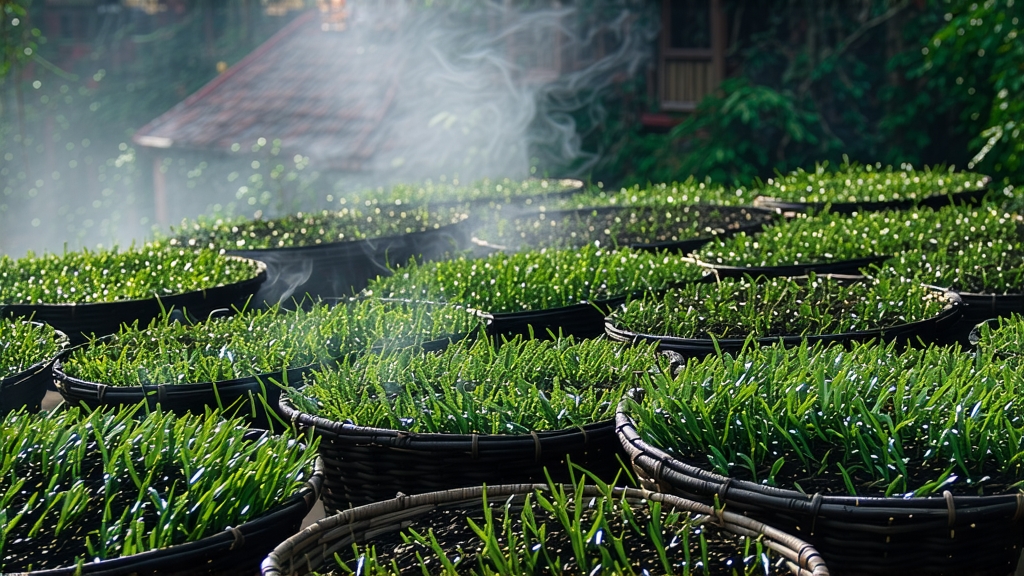
Long before English breakfast blends and afternoon tea services, there was Lapsang Souchong—the original black tea that startled the courts of Europe and set the global trade in motion. Today the name is often reduced to “smoky tea,” yet in the craggy Wuyi Shan of northern Fujian the cultivar is still coaxed into a surprisingly nuanced liquor that can taste of longan, malt, and even cacao, depending on the skill of the fireroom master. To understand why this leaf became the prototype for every black tea that followed, one must walk the stone-flagged passes of Tongmu Village at dawn, when the air is thick with pine resin and the centuries feel combustible.
History: From Ming Frontier to London Coffee-Houses
Local legend dates the birth of Lapsang Souchong to 1568, late in the Ming dynasty, when a passing army commandeered a tea factory and the workers, desperate to dry their half-oxidized leaves before spoilage, rushed them over open pine fires. The accidental smoke infusion pleased the itinerant merchants who carried the cargo down the Min River to the port of Xiamen, where Dutch buyers christened it “bohea” (a corruption of “Wuyi”) and shipped it around the Cape of Good Hope. By 1604 the first crates reached London; Samuel Pepys mentions drinking “a cup of the China drink called tee” in 1660, almost certainly Lapsang. The leaf’s assertive character survived months at sea, making it the backbone of early blended recipes and the template for Assam and Ceylon manufacture once the British began planting abroad.
Micro-Terroir: Tongmu’s Narrow Canyon
True Lapsang Souchong enjoys EU-protected geographic indication; only leaves picked within the 565 km² core of Wuyi National Park may bear the name. The canyon traps humid air rising from the Jiuqu Xi River, creating a perpetual mist that slows photosynthesis and concentrates amino acids. Soils are a coarse, mineral-rich tuff weathered from volcanic granite; locals joke that the tea tastes of stone. Two predominant cultivars endure: xiao zhong (small leaf) for sweetness and da bai (big white) for body. Spring frost risk forces the first flush to be brief—often less than ten days—so every kilogram represents a race against weather and woodsmoke.
Craft: The Fireroom Master’s Clock
Unlike orthodox black teas that wither in ambient air, Lapsang undergoes “song xun” (pine-smoke withering). Fresh leaves are laid on bamboo trays set one meter above slow-burning pine logs from Massoniana and Taiwania species whose resin content exceeds 8 %. For eighteen hours the tea is never allowed to exceed 28 °C; the goal is not heat but aromatic deposition. Once the leaves reach 60 % moisture loss they are rolled under light pressure to rupture cells, then oxidized in cedar-lined boxes where humidity hovers at 85 %. The fireroom master judges oxidation by scent alone: when the green grass note surrenders to dried longan, the leaf is briefly fired at 200 °C to halt enzymes, then re-smoked for a final thirty minutes. The entire cycle must finish within 24 hours or the pine character turns acrid.
Grades & Styles: From Traditional Smoke to Modern Honey-Aroma
International markets now recognize four grades. “Zheng Shan Xiao Zhong” is the unsmoked successor, dried over charcoal made from local hardwood; it steeps a bright copper liquor with cocoa and dried-fruit sweetness. “Traditional Lapsang” receives the full pine regimen, balanced so that smoke acts as seasoning rather than mask. “Pine Tips” consists solely of the smallest two leaves and a bud, yielding a liqueur-like texture. Finally, “Craft Reserve” is withered over embers of long-needled Taiwania root, then aged in earthen jars for three years; the smoke mellows into incense and sandalwood, a style once reserved for Qing-era tribute.
Chemistry in the Cup
Gas-chromatography studies at Fujian Agriculture University identify 42 distinct phenolic volatiles, the most prominent being guaiacol and 4-methylguaiacol—compounds also found in peated whisky. Yet when brewed at 90 °C rather than boiling, these molecules remain below human detection threshold, allowing maltol and the